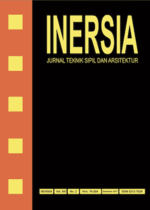Identify Location Characteristics of Tourism Accommodation that are Influenced by e-Commerce Case Study: Lembang Tourism Area, Kab. West Bandung
DOI:
https://doi.org/10.21831/inersia.v19i2.60458Keywords:
Location characteristics, e-commerce accommodation, platforms, industrial revolution, tourism accommodationAbstract
The presence of the Industrial Revolution 4.0, which is marked by the rapid development of the internet, has fundamentally changed the way humans live, work, and communicate with each other. This development has also influenced the development of the business of providing accommodation in tourist areas. The ease of obtaining information via an internet network that is connected to regional areas opens up opportunities for the public to market tourist accommodation through e-commerce accommodation. The Lembang tourist area is an area with high potential for the development of e-commerce accommodation, covering 25.64% of tourist attractions in West Bandung Regency. This research aims to determine trends and developments in the characteristics of business locations providing accommodation in the Lembang tourist area based on observations via digital platforms. Data was obtained using a spatial analysis method with two different functions. The classification function is used to review location characteristics in businesses providing accommodation based on road class. The neighborhood function is used to review location characteristics based on proximity to tourist centers. The data was then analyzed descriptively and qualitatively. The results of the research show that the development trend of e-commerce accommodation in accommodation provision businesses continues to grow from year to year. Observation results via digital platforms show that as many as 136 accommodation business units were incorporated into e-commerce accommodation in 2019 in the Lembang tourist area. The location characteristics of the business providing accommodation tend to be concentrated around tourist areas with a radius of 1 km from the tourist center. Judging from the characteristics of business locations providing accommodation on roads, it is known that 59% of business units are predominantly located on neighborhood roads, while 41% are on main roads. The ease of access offered by this digital platform influences the development of business providing accommodation and location on the road class but does not significantly affect the distance to tourist centers.
References
Barros, Carlos P. 2005. Measuring Efficiency in the Hotel Sector. Journal of Annals of Tourism Research. 32(2): 456–477.
Fauzan, Rahman. 2018. Karakteristik Model dan Analisa Peluang-Tantangan Industri 4.0. Jurnal Teknik Informatika Politeknik Hasnur. 4(1).
Hakim, Nur Imam. 2018. Pergeseran Budaya Siber dan Visual di Sektor Pariwisata Indonesia. Seminar Nasional Seni dan Desain: Konvergensi Keilmuan Seni Rupa dan Desain Era 4.0 FBS Unesa 2018.
Indrayanti, Meylia Ayu. 2013. Sistem Informasi Geografis Terapan "Vektor Analisis". Academia, diakses pada 29 April 2019. <https://www.academia.edu/5682972/Analisa_Spasial_-_Vektor>
McKinsey & Company. 2015. Industry 4.0: How to Navigate Digitization of the Manufacturing Sector. Munich: McKinsey Digital.
Pemerintah Indonesia. 2004. Undang-Undang Republik Indonesia Nomor 38 Tahun 2004 tentang Jalan. Jakarta: Sekretariat Negara.
Pemerintah Indonesia. 2009. Undang-Undang Republik Indonesia Nomor 10 Tahun 2009 tentang Kepariwisataan. Jakarta: Sekretariat Negara.
Ramdhan, Ahmad. 2014. Faktor-faktor Pemilihan Lokasi Perumahan : Studi Kasus Sukolilo Dian Regency SUrabaya. Surabaya : Institut Teknologi Sepuluh November.
Satya, Venti Eka. 2018. Strategi Indonesia Menghadapi Industri 4.0. Info Singkat Bidang Ekonomi dan Kebijakan Publik Pusat Penelitian Badan Keahlian DPR RI. 10(9): 19-24.
Soebiyantoro, Ugy. 2009. Pengaruh Ketersediaan Sarana Prasarana, Sarana Transportasi terhadap Kepuasan Wisatawan. Jurnal Manajemen Pemasaran, 4(1) : 16-22.
Sukmadinata, Nana. 2011. Metode Penelitian Pendidikan. Bandung: Remaja Rosadakarya.
Yang, Yang et al. 2012. How do Hotels Choose Their Location? Evidence from Hotels in Beijing. International Journal of Hospitality Management. 31: 675-685.
_________, 1983, Pedoman Perencanaan Lingkungan Perumahan. Yayasan Badan Penerbit Pekerjaan Umum, Jakarta.
_________. 2016. Industri Pariwisata. Indonesia-Investments, diakses pada 20 April 2019.
Downloads
Published
How to Cite
Issue
Section
License
Authors who publish with INERSIA journal agree to the following terms:
- Authors retain copyright and grant the INERSIA journal right of first publication with the work simultaneously licensed under Creative Commons Attribution License (CC BY 4.0) that allows others to share the work with an acknowledgment of the work's authorship and initial publication in this journal.
- Authors can enter into separate, additional contractual arrangements for the non-exclusive distribution of the published version of the work (e.g., post it to an institutional repository or edit it in a book), with an acknowledgment of its initial publication in this journal.
- Authors are permitted and encouraged to post their work online (e.g., in institutional repositories or on their website) before and during the submission process, as it can lead to productive exchanges, as well as earlier and greater citation of published work.

INERSIA by https://journal.uny.ac.id/index.php/inersia was distributed under a Creative Commons Attribution 4.0 International License







